technical data SKODA ROOMSTER 2008 1.G Workshop Manual
[x] Cancel search | Manufacturer: SKODA, Model Year: 2008, Model line: ROOMSTER, Model: SKODA ROOMSTER 2008 1.GPages: 248, PDF Size: 46.44 MB
Page 106 of 248
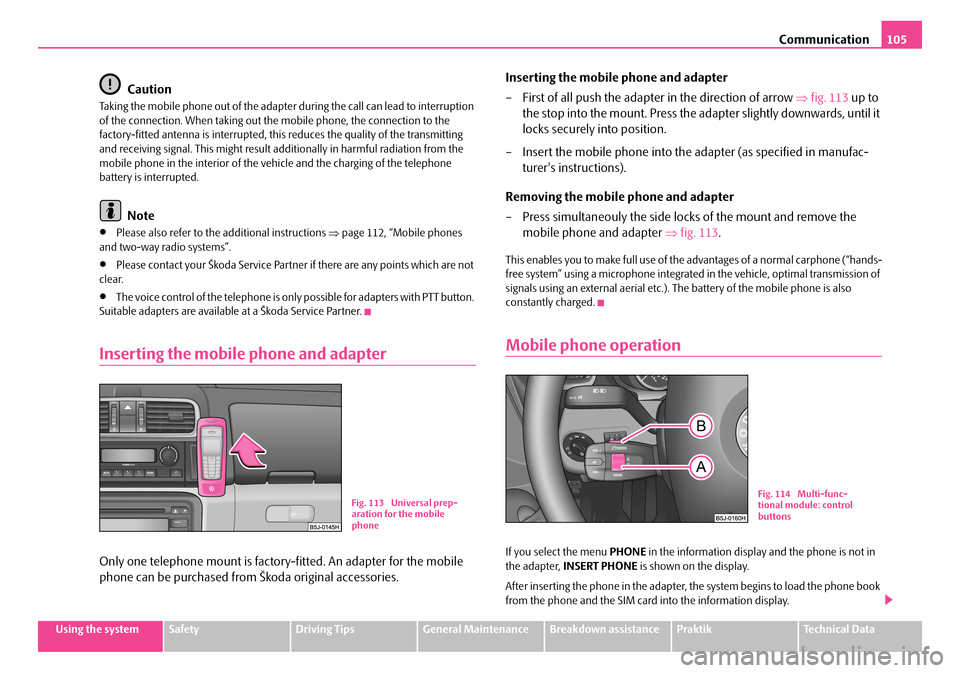
Communication105
Using the systemSafetyDriving TipsGeneral MaintenanceBreakdown assistancePraktikTechnical Data
Caution
Taking the mobile phone out of the adapter during the call can lead to interruption of the connection. When taking out the mobile phone, the connection to the factory-fitted antenna is interrupted, this reduces the quality of the transmitting and receiving signal. This might result additionally in harmful radiation from the mobile phone in the interior of the ve hicle and the charging of the telephone battery is interrupted.
Note
•Please also refer to the additional instructions ⇒page 112, “Mobile phones and two-way radio systems”.
•Please contact your Škoda Service Partner if there are any points which are not clear.
•The voice control of the telephone is only possible for adapters with PTT button. Suitable adapters are available at a Škoda Service Partner.
Inserting the mobile phone and adapter
Only one telephone mount is factory-fitted. An adapter for the mobile
phone can be purchased from Škoda original accessories.
Inserting the mobile phone and adapter
– First of all push the adapter in the direction of arrow ⇒fig. 113 up to
the stop into the mount. Press the ad apter slightly downwards, until it
locks securely into position.
– Insert the mobile phone into the adapter (as specified in manufac-
turer's instructions).
Removing the mobile phone and adapter
– Press simultaneouly the side locks of the mount and remove the
mobile phone and adapter ⇒fig. 113.
This enables you to make full use of the advantages of a normal carphone (“hands- free system” using a microphone integrated in the vehicle, optimal transmission of signals using an external aerial etc.). The battery of the mobile phone is also constantly charged.
Mobile phone operation
If you select the menu PHONE in the information display and the phone is not in the adapter, INSERT PHONE is shown on the display.
After inserting the phone in the adapter, the system begins to load the phone book from the phone and the SIM card into the information display.
Fig. 113 Universal prep- aration for the mobile phone
Fig. 114 Multi-func-tional module: control buttons
NKO A05R 20 MR08.book Page 105 Wednesday, March 28, 2007 9:42 AM
Page 108 of 248
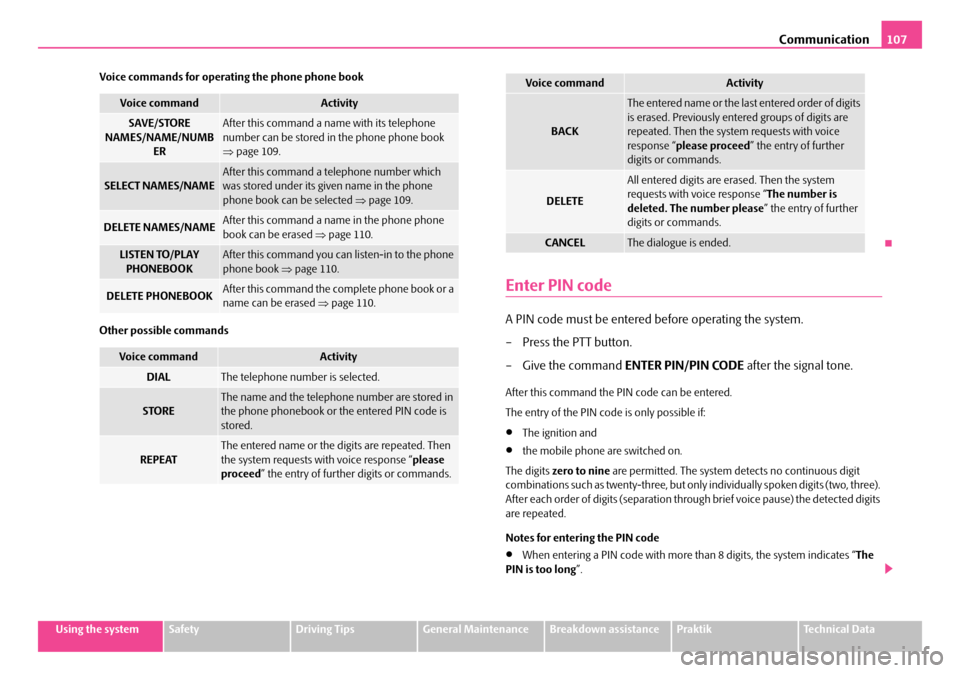
Communication107
Using the systemSafetyDriving TipsGeneral MaintenanceBreakdown assistancePraktikTechnical Data
Voice commands for operating the phone phone book
Other possible commands
Enter PIN code
A PIN code must be entered before operating the system.
– Press the PTT button.
– Give the command ENTER PIN/PIN CODE after the signal tone.
After this command the PIN code can be entered.
The entry of the PIN code is only possible if:
•The ignition and
•the mobile phone are switched on.
The digits zero to nine are permitted. The system detects no continuous digit combinations such as twenty-three, but only individually spoken digits (two, three). After each order of digits (separation through brief voice pause) the detected digits are repeated.
Notes for entering the PIN code
•When entering a PIN code with more than 8 digits, the system indicates “ The PIN is too long ”.
Voice commandActivity
SAVE/STORE NAMES/NAME/NUMB ER
After this command a name with its telephone number can be stored in the phone phone book ⇒ page 109.
SELECT NAMES/NAMEAfter this command a telephone number which was stored under its given name in the phone phone book can be selected ⇒page 109.
DELETE NAMES/NAMEAfter this command a name in the phone phone book can be erased ⇒page 110.
LISTEN TO/PLAY PHONEBOOKAfter this command you ca n listen-in to the phone phone book ⇒page 110.
DELETE PHONEBOOKAfter this command the complete phone book or a name can be erased ⇒page 110.
Voice commandActivity
DIALThe telephone number is selected.
STOREThe name and the telephone number are stored in the phone phonebook or the entered PIN code is stored.
REPEATThe entered name or the digits are repeated. Then the system requests with voice response “ please proceed ” the entry of further digits or commands.
BACK
The entered name or the last entered order of digits is erased. Previously entered groups of digits are repeated. Then the system requests with voice response “ please proceed” the entry of further digits or commands.
DELETE
All entered digits are erased. Then the system requests with voice response “ The number is deleted. The number please ” the entry of further digits or commands.
CANCELThe dialogue is ended.
Voice commandActivity
NKO A05R 20 MR08.book Page 107 Wednesday, March 28, 2007 9:42 AM
Page 110 of 248
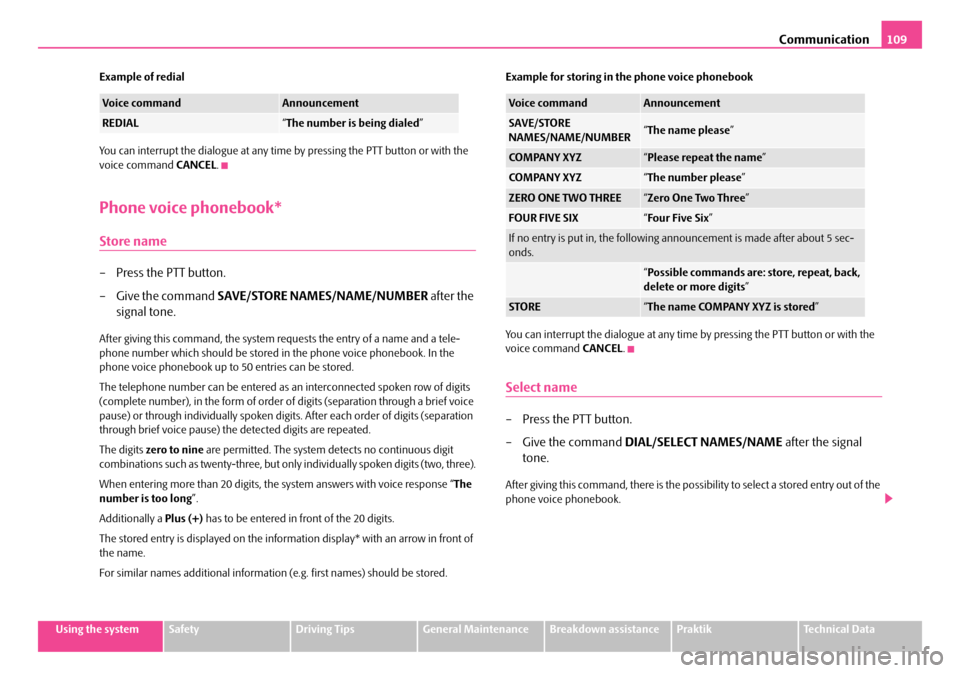
Communication109
Using the systemSafetyDriving TipsGeneral MaintenanceBreakdown assistancePraktikTechnical Data
Example of redial
You can interrupt the dialogue at any time by pressing the PTT button or with the voice command CANCEL.
Phone voice phonebook*
Store name
– Press the PTT button.
– Give the command SAVE/STORE NAMES/NAME/NUMBER after the
signal tone.
After giving this command, the system requests the entry of a name and a tele- phone number which should be stored in the phone voice phonebook. In the phone voice phonebook up to 50 entries can be stored.
The telephone number can be entered as an interconnected spoken row of digits (complete number), in the form of order of digits (separation through a brief voice pause) or through individually spoken digi ts. After each order of digits (separation through brief voice pause) the detected digits are repeated.
The digits zero to nine are permitted. The system detects no continuous digit combinations such as twenty-three, but only individually spoken digits (two, three).
When entering more than 20 digits, the system answers with voice response “ The number is too long ”.
Additionally a Plus (+) has to be entered in front of the 20 digits.
The stored entry is displayed on the information display* with an arrow in front of the name.
For similar names additional information (e.g. first names) should be stored.
Example for storing in the phone voice phonebook
You can interrupt the dialogue at any time by pressing the PTT button or with the voice command CANCEL.
Select name
– Press the PTT button.
– Give the command DIAL/SELECT NAMES/NAME after the signal
tone.
After giving this command, there is the possibility to select a stored entry out of the phone voice phonebook.
Voice commandAnnouncement
REDIAL“ The number is being dialed”
Voice commandAnnouncement
SAVE/STORE NAMES/NAME/NUMBER“ The name please”
COMPANY XYZ“Please repeat the name”
COMPANY XYZ“The number please”
ZERO ONE TWO THREE“Zero One Two Three”
FOUR FIVE SIX“Four Five Six”
If no entry is put in, the following announcement is made after about 5 sec- onds.
“ Possible commands are: store, repeat, back, delete or more digits ”
STORE“The name COMPANY XYZ is stored”
NKO A05R 20 MR08.book Page 109 Wednesday, March 28, 2007 9:42 AM
Page 112 of 248
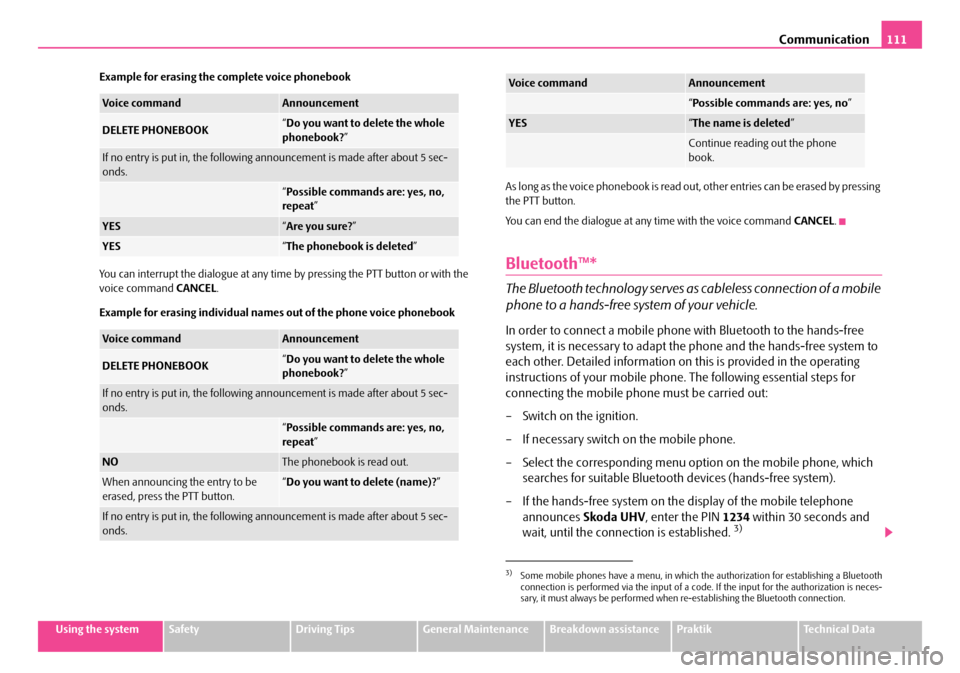
Communication111
Using the systemSafetyDriving TipsGeneral MaintenanceBreakdown assistancePraktikTechnical Data
Example for erasing the complete voice phonebook
You can interrupt the dialogue at any time by pressing the PTT button or with the voice command CANCEL.
Example for erasing individual name s out of the phone voice phonebook
As long as the voice phonebook is read out, other entries can be erased by pressing the PTT button.
You can end the dialogue at any time with the voice command CANCEL.
Bluetooth™*
The Bluetooth technology serves as cableless connection of a mobile
phone to a hands-free system of your vehicle.
In order to connect a mobile phon e with Bluetooth to the hands-free
system, it is necessary to adapt the phone and the hands-free system to
each other. Detailed information on this is provided in the operating
instructions of your mobile phone. The following essential steps for
connecting the mobile phone must be carried out:
– Switch on the ignition.
– If necessary switch on the mobile phone.
– Select the corresponding menu option on the mobile phone, which
searches for suitable Bluetoot h devices (hands-free system).
– If the hands-free system on the display of the mobile telephone
announces Skoda UHV, enter the PIN 1234 within 30 seconds and
wait, until the connection is established. 3)
Voice commandAnnouncement
DELETE PHONEBOOK“ Do you want to delete the whole phonebook? ”
If no entry is put in, the following announcement is made after about 5 sec- onds.
“ Possible commands are: yes, no, repeat ”
YES“Are you sure?”
YES“The phonebook is deleted”
Voice commandAnnouncement
DELETE PHONEBOOK“Do you want to delete the whole phonebook? ”
If no entry is put in, the following announcement is made after about 5 sec- onds.
“ Possible commands are: yes, no, repeat ”
NOThe phonebook is read out.
When announcing the entry to be erased, press the PTT button.“ Do you want to delete (name)?”
If no entry is put in, the following announcement is made after about 5 sec- onds.
“ Possible commands are: yes, no”
YES“The name is deleted”
Continue reading out the phone book.
3)Some mobile phones have a menu, in which the authorization for establishing a Bluetooth connection is performed via the input of a code. If the input for the authorization is neces-sary, it must always be performed when re-establishing the Bluetooth connection.
Voice commandAnnouncement
NKO A05R 20 MR08.book Page 111 Wednesday, March 28, 2007 9:42 AM
Page 114 of 248
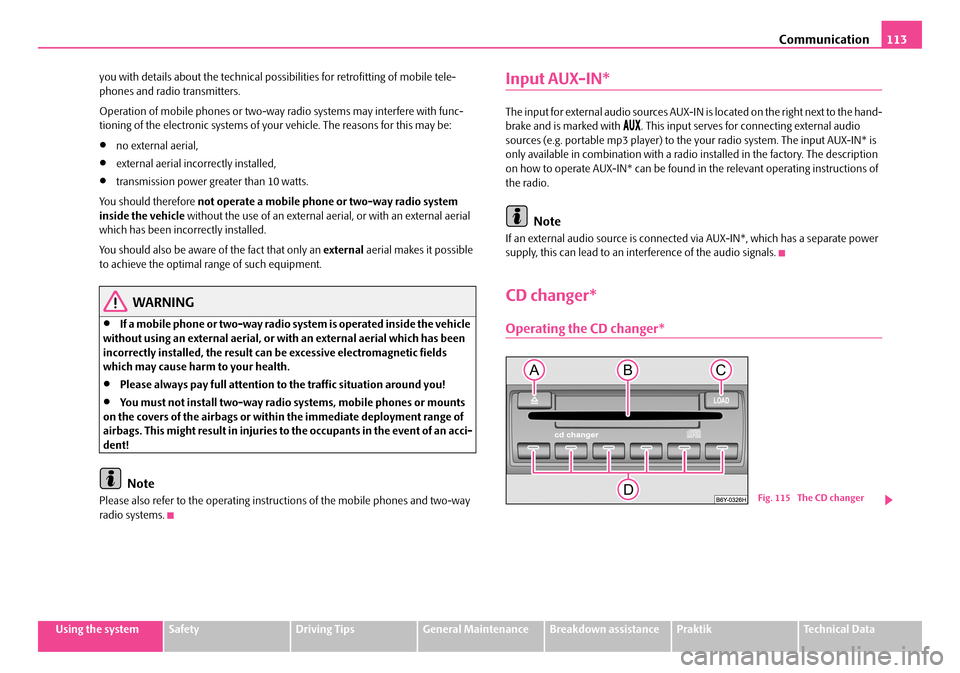
Communication113
Using the systemSafetyDriving TipsGeneral MaintenanceBreakdown assistancePraktikTechnical Data
you with details about the technical possibilities for retrofitting of mobile tele- phones and radio transmitters.
Operation of mobile phones or two-way radio systems may interfere with func- tioning of the electronic systems of your vehicle. The reasons for this may be:
•no external aerial,
•external aerial incorrectly installed,
•transmission power greater than 10 watts.
You should therefore not operate a mobile phone or two-way radio system inside the vehicle without the use of an external aerial, or with an external aerial which has been incorrectly installed.
You should also be aware of the fact that only an external aerial makes it possible to achieve the optimal range of such equipment.
WARNING
•If a mobile phone or two-way radio sy stem is operated inside the vehicle without using an external aerial, or wi th an external aerial which has been incorrectly installed, the result can be excessive electromagnetic fields which may cause harm to your health.
•Please always pay full attention to the traffic situation around you!
•You must not install two-way radio systems, mobile phones or mounts on the covers of the airbags or within the immediate deployment range of airbags. This might result in injuries to the occupants in the event of an acci- dent!
Note
Please also refer to the operating instru ctions of the mobile phones and two-way radio systems.
Input AUX-IN*
The input for external audio sources AUX-IN is located on the right next to the hand- brake and is marked with . This input serves for connecting external audio sources (e.g. portable mp3 player) to the your radio system. The input AUX-IN* is only available in combination with a radio installed in the factory. The description on how to operate AUX-IN* can be found in the relevant operating instructions of the radio.
Note
If an external audio source is connected via AUX-IN*, which has a separate power supply, this can lead to an interference of the audio signals.
CD changer*
Operating the CD changer*
Fig. 115 The CD changer
NKO A05R 20 MR08.book Page 113 Wednesday, March 28, 2007 9:42 AM
Page 116 of 248
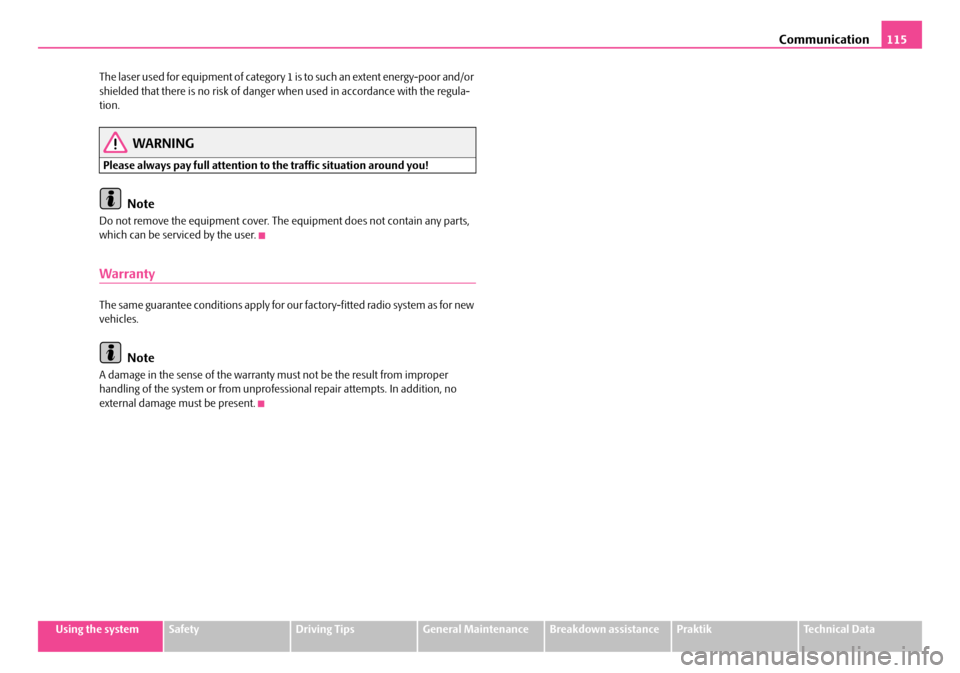
Communication115
Using the systemSafetyDriving TipsGeneral MaintenanceBreakdown assistancePraktikTechnical Data
The laser used for equipment of category 1 is to such an extent energy-poor and/or shielded that there is no ri sk of danger when used in accordance with the regula- tion.
WARNING
Please always pay full attention to the traffic situation around you!
Note
Do not remove the equipment cover. The equipment does not contain any parts, which can be serviced by the user.
Warranty
The same guarantee conditions apply for our factory-fitted radio system as for new vehicles.
Note
A damage in the sense of the warranty must not be the result from improper handling of the system or from unprofessional repair attempts. In addition, no external damage must be present.
NKO A05R 20 MR08.book Page 115 Wednesday, March 28, 2007 9:42 AM
Page 118 of 248
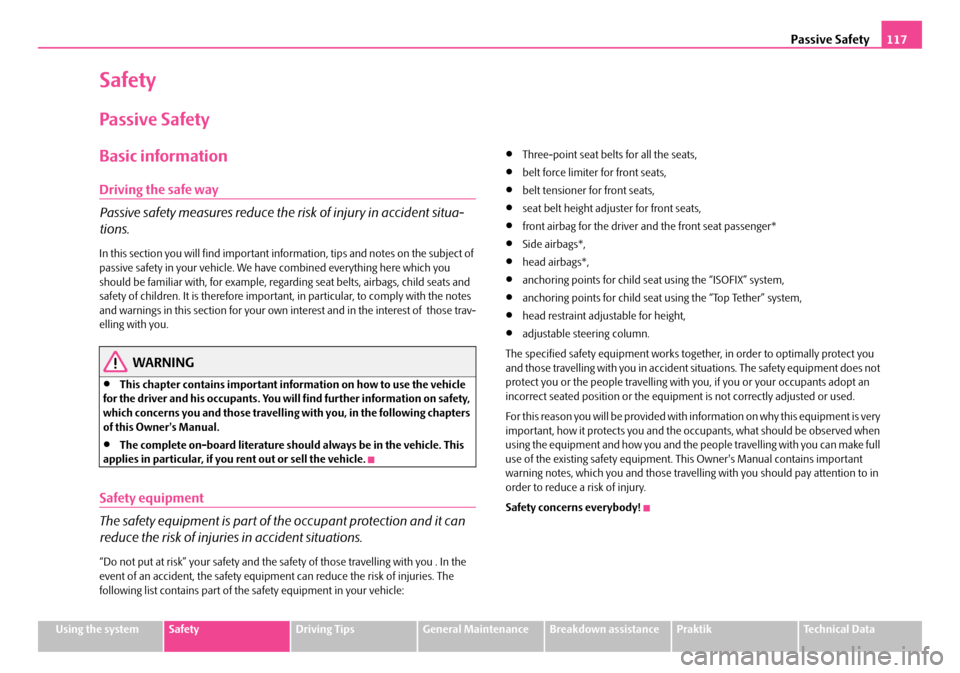
Passive Safety117
Using the systemSafetyDriving TipsGeneral MaintenanceBreakdown assistancePraktikTechnical Data
Safety
Passive Safety
Basic information
Driving the safe way
Passive safety measures reduce the risk of injury in accident situa-
tions.
In this section you will find important inform ation, tips and notes on the subject of passive safety in your vehicle. We ha ve combined everything here which you should be familiar with, for example, regarding seat belts, airbags, child seats and safety of children. It is therefore importan t, in particular, to comply with the notes and warnings in this section for your own interest and in the interest of those trav- elling with you.
WARNING
•This chapter contains important information on how to use the vehicle for the driver and his occupants. You will find further information on safety, which concerns you and those travelling with you, in the following chapters of this Owner's Manual.
•The complete on-board literature should always be in the vehicle. This applies in particular, if you rent out or sell the vehicle.
Safety equipment
The safety equipment is part of the occupant protection and it can
reduce the risk of injuries in accident situations.
“Do not put at risk” your safety and the safety of those travelling with you . In the event of an accident, the safety equipmen t can reduce the risk of injuries. The following list contains part of th e safety equipment in your vehicle:
•Three-point seat belts for all the seats,
•belt force limiter for front seats,
•belt tensioner for front seats,
•seat belt height adjuster for front seats,
•front airbag for the driver and the front seat passenger*
•Side airbags*,
•head airbags*,
•anchoring points for child seat using the “ISOFIX” system,
•anchoring points for child seat using the “Top Tether” system,
•head restraint adjustable for height,
•adjustable steering column.
The specified safety equipment works toge ther, in order to optimally protect you and those travelling with you in accident situations. The safety equipment does not protect you or the people travelling with you, if you or your occupants adopt an incorrect seated position or the equipmen t is not correctly adjusted or used.
Fo r t h i s re a s o n y o u w i l l b e p ro v i d e d w i th i n fo rm a ti o n o n w hy t h i s e q u i p m e nt i s v e r y important, how it protects you and the o ccupants, what should be observed when using the equipment and how you and the pe ople travelling with you can make full use of the existing safety equipment. This Owner's Manual contains important warning notes, which you and those travelli ng with you should pay attention to in order to reduce a risk of injury.
Safety concerns everybody!
NKO A05R 20 MR08.book Page 117 Wednesday, March 28, 2007 9:42 AM
Page 120 of 248
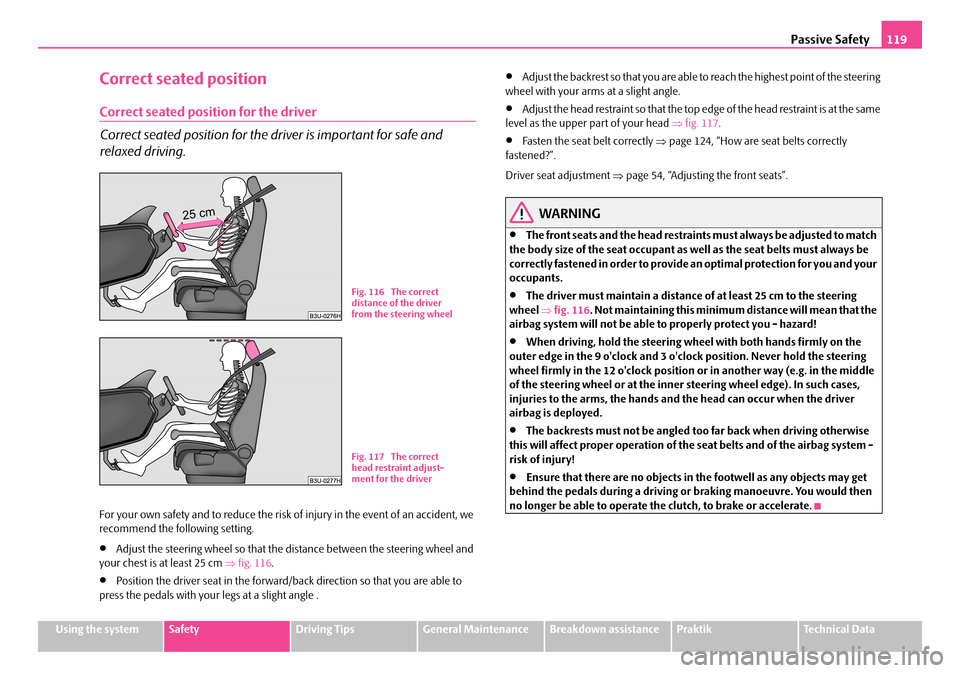
Passive Safety119
Using the systemSafetyDriving TipsGeneral MaintenanceBreakdown assistancePraktikTechnical Data
Correct seated position
Correct seated position for the driver
Correct seated position for the driver is important for safe and
relaxed driving.
For your own safety and to reduce the risk of injury in the event of an accident, we recommend the following setting.
•Adjust the steering wheel so that the distance between the steering wheel and your chest is at least 25 cm ⇒fig. 116.
•Position the driver seat in the forward/back direction so that you are able to press the pedals with your legs at a slight angle .
•Adjust the backrest so that you are able to reach the highest point of the steering wheel with your arms at a slight angle.
•Adjust the head restraint so that the top edge of the head restraint is at the same level as the upper part of your head ⇒fig. 117.
•Fasten the seat belt correctly ⇒page 124, “How are seat belts correctly fastened?”.
Driver seat adjustment ⇒page 54, “Adjusting the front seats”.
WARNING
•The front seats and the head restraints must always be adjusted to match the body size of the seat occupant as well as the seat belts must always be correctly fastened in order to provide an optimal protection for you and your occupants.
•The driver must maintain a distance of at least 25 cm to the steering wheel ⇒fig. 116. Not maintaining this minimum distance will mean that the airbag system will not be able to properly protect you - hazard!
•When driving, hold the steering wheel with both hands firmly on the outer edge in the 9 o'clock and 3 o'clock position. Never hold the steering wheel firmly in the 12 o'clock position or in another way (e.g. in the middle of the steering wheel or at the inner steering wheel edge). In such cases, injuries to the arms, the hands and the head can occur when the driver airbag is deployed.
•The backrests must not be angled to o far back when driving otherwise this will affect proper operation of the seat belts and of the airbag system - risk of injury!
•Ensure that there are no objects in the footwell as any objects may get behind the pedals during a driving or braking manoeuvre. You would then no longer be able to operate the clutch, to brake or accelerate.
Fig. 116 The correct distance of the driver from the steering wheel
Fig. 117 The correct head restraint adjust-ment for the driver
NKO A05R 20 MR08.book Page 119 Wednesday, March 28, 2007 9:42 AM
Page 122 of 248
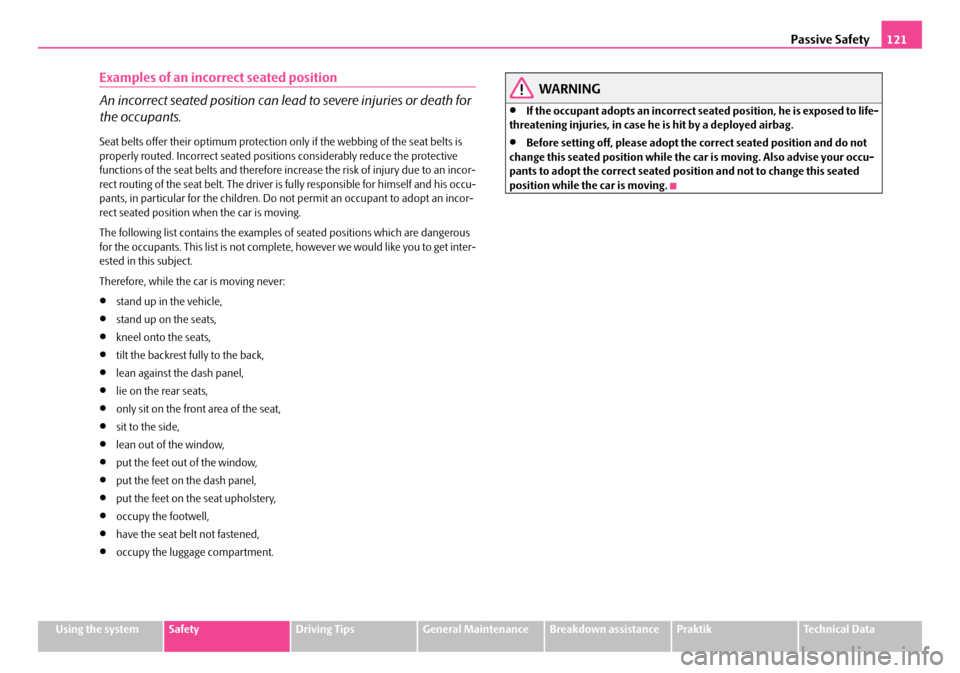
Passive Safety121
Using the systemSafetyDriving TipsGeneral MaintenanceBreakdown assistancePraktikTechnical Data
Examples of an incorrect seated position
An incorrect seated position can lead to severe injuries or death for
the occupants.
Seat belts offer their optimum protection only if the webbing of the seat belts is properly routed. Incorrect seated positi ons considerably reduce the protective functions of the seat belts and therefore increase the risk of injury due to an incor-rect routing of the seat belt. The driver is fully responsible for himself and his occu- pants, in particular for the children. Do not permit an occupant to adopt an incor- rect seated position when the car is moving.
The following list contains the examples of seated positions which are dangerous for the occupants. This list is not comple te, however we would like you to get inter- ested in this subject.
Therefore, while the car is moving never:
•stand up in the vehicle,
•stand up on the seats,
•kneel onto the seats,
•tilt the backrest fully to the back,
•lean against the dash panel,
•lie on the rear seats,
•only sit on the front area of the seat,
•sit to the side,
•lean out of the window,
•put the feet out of the window,
•put the feet on the dash panel,
•put the feet on the seat upholstery,
•occupy the footwell,
•have the seat belt not fastened,
•occupy the luggage compartment.
WARNING
•If the occupant adopts an incorrect seated position, he is exposed to life- threatening injuries, in case he is hit by a deployed airbag.
•Before setting off, please adopt the correct seated position and do not change this seated position while the car is moving. Also advise your occu- pants to adopt the correct seated position and not to change this seated position while the car is moving.
NKO A05R 20 MR08.book Page 121 Wednesday, March 28, 2007 9:42 AM
Page 124 of 248
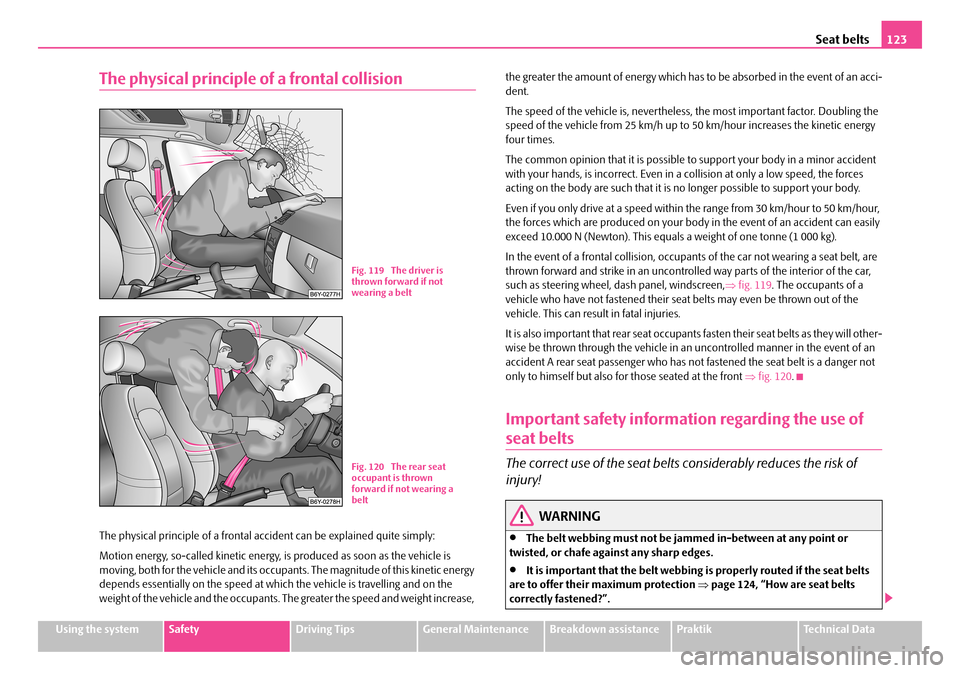
Seat belts123
Using the systemSafetyDriving TipsGeneral MaintenanceBreakdown assistancePraktikTechnical Data
The physical principle of a frontal collision
The physical principle of a frontal accident can be explained quite simply:
Motion energy, so-called kinetic energy, is produced as soon as the vehicle is moving, both for the vehicle and its occupants. The magnitude of this kinetic energy depends essentially on the speed at which the vehicle is travelling and on the weight of the vehicle and the occupants. The greater the speed and weight increase,
the greater the amount of energy which has to be absorbed in the event of an acci- dent.
The speed of the vehicle is, nevertheless, the most important factor. Doubling the speed of the vehicle from 25 km/h up to 50 km/hour increases the kinetic energy four times.
The common opinion that it is possible to support your body in a minor accident with your hands, is incorrect. Even in a collision at only a low speed, the forces acting on the body are such that it is no longer possible to support your body.
Even if you only drive at a speed within the range from 30 km/hour to 50 km/hour, the forces which are produced on your body in the event of an accident can easily exceed 10.000 N (Newton). This equals a weight of one tonne (1 000 kg).
In the event of a frontal collision, occupants of the car not wearing a seat belt, are thrown forward and strike in an uncontrolle d way parts of the interior of the car, such as steering wheel, dash panel, windscreen, ⇒fig. 119. The occupants of a vehicle who have not fastened their seat belts may even be thrown out of the vehicle. This can resu lt in fatal injuries.
It is also important that rear seat occupants fasten their seat belts as they will other- wise be thrown through the vehicle in an uncontrolled manner in the event of an accident A rear seat passenger who has not fastened the seat belt is a danger not only to himself but also fo r those seated at the front ⇒fig. 120.
Important safety information regarding the use of
seat belts
The correct use of the seat belts considerably reduces the risk of
injury!
WARNING
•The belt webbing must not be jammed in-between at any point or twisted, or chafe against any sharp edges.
•It is important that the belt webbing is properly routed if the seat belts are to offer their maximum protection ⇒page 124, “How are seat belts correctly fa stened?”.
Fig. 119 The driver is thrown forward if not wearing a belt
Fig. 120 The rear seat occupant is thrown forward if not wearing a belt
NKO A05R 20 MR08.book Page 123 Wednesday, March 28, 2007 9:42 AM